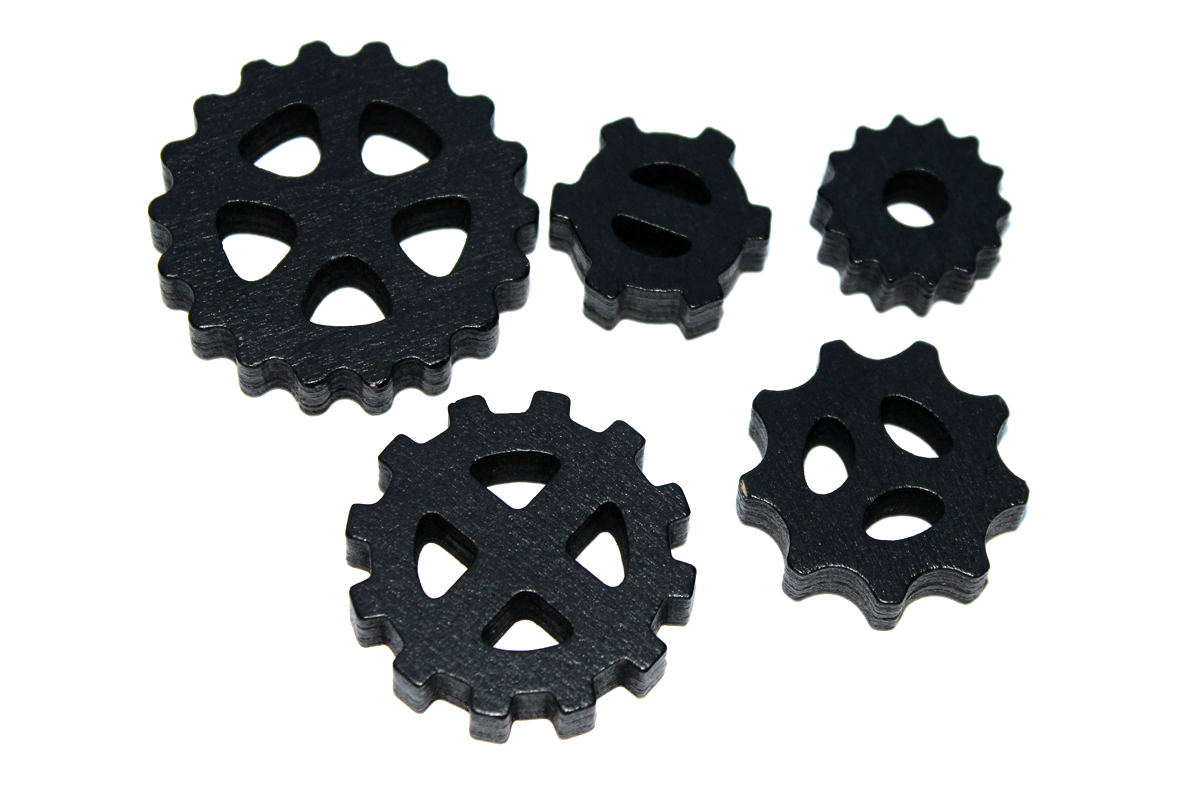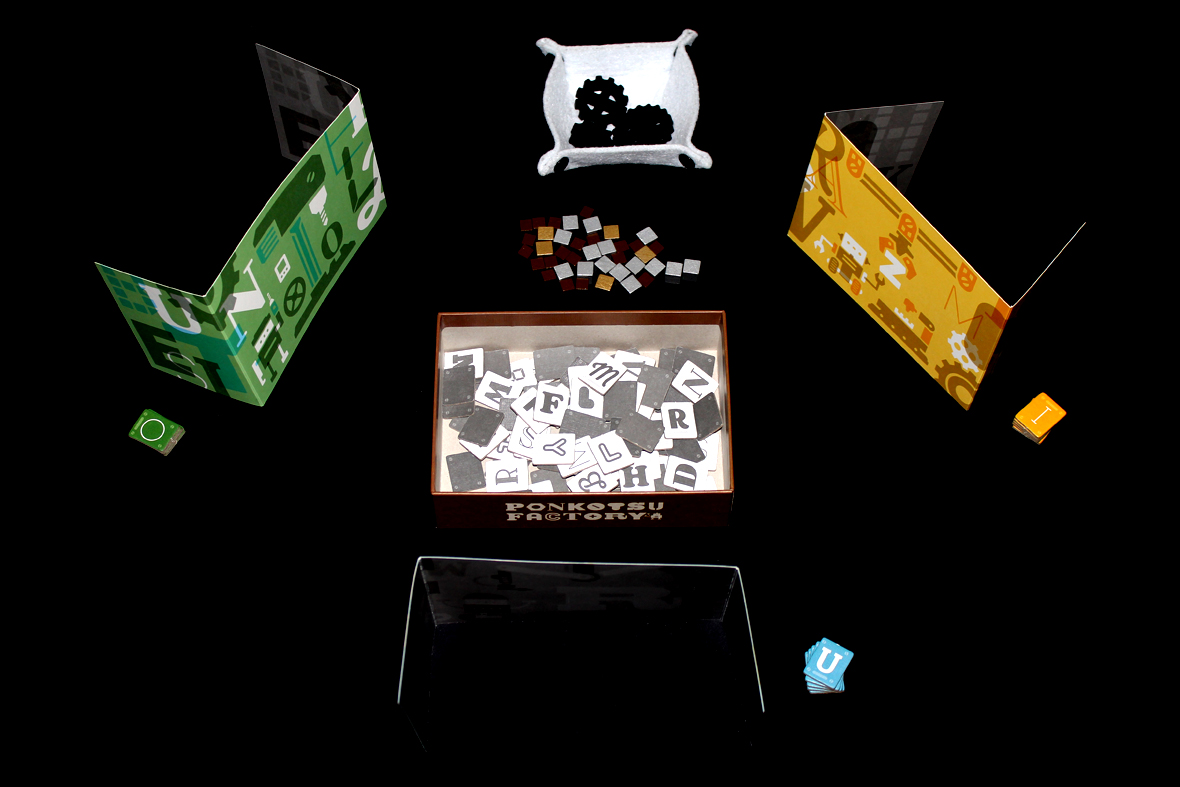
Base price: Not sure.
2 – 5 players.
Play time: ~15 – 30 minutes.
BGG | Board Game Atlas
Logged plays: 4
Full disclosure: A review copy of Ponkotsu Factory was provided by itten.
So, along with the doujin games, the games from Korea, Mandoo’s box of games, and a box from IDW, I also got a box of games to check out from itten! That’s all very exciting, but it is also a lot, which is why I’m writing this review at the very beginning of May and I have no idea when I’m going to publish it. It’s going to be an adventure! Either way, itten is making its US presence known at conventions this year, so I’d like to talk about their titles in case you see them there. Let’s start with Ponkotsu Factory, but I have much more to say in the future.
In Ponkotsu Factory, you play as robots, trying to reassemble the words you’ve been given. That’s the problem with letters, though; they don’t just only fit in one particular configuration. Keep trying, though, and maybe you’ll figure out just what you were originally given. Will you be able to finish your reassembly and match up? Or will you just end up scrambled?
Contents
Setup
Not much to do. Give every player a player screen:

And give them each a set of vowels in the matching color:

There are five gears; pull them out and set as many in the center as there are players. The game recommends leaving the larger gears in the box if you have fewer than five players, but we like big gears so we usually use those first:

Set aside the point tokens, as well:

Gold is 10, Silver is 3, Brown is 1. Now, give each player 15 random letters!

You’re ready to start!

There’s also a sand timer, but I told y’all I wasn’t going to take pictures of that anymore.
Gameplay

Gameplay is surprisingly not too challenging. The game is played in two phases, essentially, where you try to confuse your opponents to score points. After four rounds, the player with the most points wins!
To begin a round, you take 15 letters and combine them with your vowels for 20 letters total. Use those letters to make 3 four-letter words, following these rules:
- No proper nouns.
- Singular words / infinitive forms only.
- No swear words. It says it in the rules!

Once you’re done, write them down, so that you don’t cheat later. Put the vowels of yours you didn’t use aside, and return the other letters you didn’t use to the supply. Every player should shuffle up the 12 letters that comprise their three words, and then pass them to another player (this should be a different player every time, if you can do that). Once everyone has a set, count down from three and then start the second phase!
During the second phase, you’re going to rapidly try to assemble 3 four-letter words from the letters you were given. As soon as you’ve done so, take the largest remaining gear. If you are the first player to take a gear, flip the sand timer, as well. This gives the other players one minute to finish their words. Once everyone’s finished or time runs out, you’ll move on to scoring.

To score, you award points for quickness and correctness. For quickness, give points based on the size of the gear you got, starting at 5 for the first gear and 1 for the last gear. At lower player counts, you’ll start with smaller gears, so scale down appropriately (4 – 1 at 4 players, 2 / 1 at two players, etc.). Note that if time ran out and you didn’t assemble three words and take a gear, you get 0 points in this phase.
For correctness, go around the table and have each player read off the words that they wrote down. If they gave you their letters, you score 1 bonus point for every word of theirs that you created during your reassembly. You can still score these points even if you didn’t assemble three words. Also, if your opponent reads off a word that’s fake or misspelled, they must give you one of their points.

Give players their vowels back and go again! After four rounds, the player with the most points wins!
Player Count Differences
Not many, honestly. With more players, there’s more of an opportunity to distinguish yourself by being the fastest, but someone‘s still getting 4 points. Your goal basically becomes making sure it’s a different person every time so that you can start breaking away from the points pack. Beyond that, someone’s giving you somewhat random letters every round; it shouldn’t matter how many people there are. I was actually pleasantly surprised with this at two players; I thought I was not going to enjoy it, but I ended up liking it quite a bit! So, to that end, I have no strong feelings about player count for this one.
Strategy
- Make challenging words. This is where the game gets cruel, but you’ve got to go for the throat if you want to come out a winner in this one. You should be looking for words with strange configurations or words where the letters look like they should form something else / not belong to this word. One of the most successful rounds I had was when I used the word SASS, for instance. The multiple S tiles really threw off my opponent and I was able to keep them from scoring any points on quickness. Unfortunately, they clapped back at me with CYST, and I wasn’t thinking about Y as a vowel, so I quickly got messed up by that. Use the complicated letters to your advantage — J, X, Q, Y, K; all are really good. Also weird suffixes and prefixes will take you far. BALK is a great word; HYPE is a great word; EVEN is a great word, too. You’ll need to come out swinging with your best words if you want to try and throw your opponent off badly enough that they miss out on scoring entirely.
- Just make sure your words aren’t too specific. What you don’t want to happen is to, say, go for POOR, QUAY, and CYST; other than QUAY, COPY, SORT, there aren’t a whole lot of sets of four-letter words that will fit with those letters. If your opponent can crack one, they can usually crack the others, and then you’ve given them three bonus points! The ideal set to send is one that is tough to figure out because it gives too many bad options, not because it’s specific enough that only one good configuration exists.
- Reassemble quickly. This kind of goes without saying, but if you’re not getting those points from quickly putting the words back together, someone else is. You need to be flying through it, and honestly, go with your gut. It’s almost impossible to guess if the word was SEAT or SATE (though you know for a fact it wasn’t TEAS). If you know your opponent well, you can go for the guess, but generally speaking I just tell people to get to whatever the first thing they can come up with is; other players aren’t always so lucky.
- Don’t make up fake words. Yes, you only lose one point and you might be able to keep your opponent from getting any, but it sucks to do that. It kind of goes without saying that that’s against the spirit of the game, but I’m still going to mention it explicitly.
Pros, Mehs, and Cons
Pros
- Cute theme. You play as robots quickly reassembling letters to make new words! It’s adorable, if a little on-the-nose.
- I love real-time games. They’re so much fun! Plus they avoid analysis paralysis by actively penalizing it, something that I’m always here for in a board game. It helps at work sometimes.
- I also love word games. It’s one of my favorite categories of games to play; I just wish I got to do so more often. I feel like word games are one of those genres that you don’t see a lot of things happening in as much as other ones. Now I just need to find a roll and write word game and I’m set. Probably. Or I’m even worse off than before.
- The gears are really nice components. They have a good weight to them and it’s easy to see how many points you should score from them, which I doubly appreciate.
Mehs
- I wish there were better ways to track your chosen words than “use a post-it note and stick it to the inside of your player screen”. I’m not sure what would be better and still fit in the box, but I worry when filling out my post-it that other players can see what I’m writing and are (hopefully inadvertently) looking at my words.
- It’s weird that Silver is 3. It makes more sense for Silver to be 5, but honestly you can just house rule it if you care as much about it as I do (which is, to say, too much).
Cons
- Definitely a game you can get knocked out of pretty aggressively. If you spend the first two rounds not scoring, you aggressively get locked in a situation where even if you do pretty well, your opponents will likely still outpace you, which isn’t always fun. It’s how things go, but it’s not always the most fun. That said, there’s no reason that you can’t just play as many rounds as you want; 4 is just the rules recommendation. Allow new players some practice rounds and you’ll probably enjoy the game more.
- Some of the letters are a bit hard to read. The lines help but I still occasionally mix up the Ms and the Ws.
Overall: 8.5 / 10

Overall, I really enjoy Ponktosu Factory! Naturally, it’s already got a lot going for it, because it combines two of my favorite game types: real-time games and word games, but I think it’s also got a cute theme, and I’m all about that. I could see a version of this maybe being a bit more mass-market successful if it were just bigger, across the board; larger tiles, larger screens, larger box, but I don’t think that’s generally itten’s style, and I can appreciate that. As it stands, it’s a compact, real-time, wordy party-esque game, and that suits me just fine. I do really appreciate that it works so well at two players, too; I can see myself playing this against one of my coworkers a lot in the future. It’s a great length for a lunch game. Anyways, if you’re a fan of offbeat little word games, real-time games, or you’re looking for a new way to burn a small part of your brain out with anagrams, I’d definitely recommend trying out Ponkotsu Factory! I think it’s a bunch of fun.